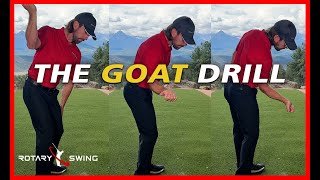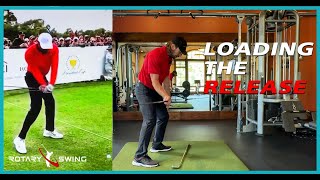Today we're going to look at a problem we see a lot at the Rotary Swing Golf Academy.
The first thing we do when a golfer comes in for a lesson is look at the foundation of the golf swing, which is of course the setup.
This may seem like a mundane, monotonous topic that we've covered before, but it's still one of the top problems we see, so we're going to look at the pitfalls that come about because of it.
MYTH: Weight Should Be on the Balls of the Feet
Today we're going to focus on a golf myth that we've all heard. Have you ever picked up a golf book or gone to an instructor and been told that your weight is meant to be on the balls of your feet? They all say it.
They make you put the club down and they ask you, "Did you ever play baseball when you were a kid? What position did you play? Second base? Perfect, perfect. Show me what you would do when you were getting ready for a ground ball, or when the pitcher's getting ready to throw the pitch."
They have you get down and crouch with the weight on the balls of your feet because that way you're ready to move in any direction.
This is what golfers have been told for years. Most golf instructors learn this information and pass it on to their students every day, without ever considering a simple question that would completely change their minds about what many consider a fundamental of the golf swing.
The question is simply this: in the golf swing, at what point do we want to be ready to move in any direction? Our goal is not to keep moving. Our goal is to stay centered and rotate around the anchored base that we create. We're building a solid foundation around which to rotate.
It's that simple.
Forget what you've heard about the balls of the feet. You can have a good swing and good moves, but if your weight is not distributed correctly at setup, the entire sequence of the golf swing is thrown off.
We'll walk through the setup to see the problems caused by setting up on the balls of the feet, then look at how to fix the problem and what you can work on at home.
Setup: You're in Control
Of course the setup is the foundation of the golf swing but, just as importantly, it's the one variable that you can absolutely do 100 percent correctly every single time. With a little bit of practice, you can get into the correct setup position every time, and it will increase your success tremendously.
Most golfers set up on the balls of their feet when they first come to see us. The setup may look pretty good at first - you can't always tell by looking that the weight is up on the balls of the feet.
As they start to take the club back, though, even if they make a good move away from the golf ball, their lower body starts to have to fight for stability. Their heels may even lift a little bit off the ground as they work to keep their balance.
What Happens to the Golf Swing?
At this point in the golf swing, you've already done two very detrimental things:
-
You've lost your connection to the ground, which is meant to be the base that you'll draw power from on the downswing.
-
There's no way you can correctly perform the weight shift from this position. You've probably seen the Weight Shift and Transition lessons already, so you know how important the weight shift is. You can't do it when you're leaning forward like that.
As you can see in the photo above, in the effort to keep your balance, your head leans closer to the ball. You really only have two possibilities once you get into that leaning position.
You lose your spine angle. This is another big complaint we hear. If you continue down, your body's going to sense that you're in trouble and actually start to back up out of your spine angle.
You end up standing almost straight up at impact, because you have no choice. You've leaned in toward the golf ball in an effort to keep your balance, so now you have to create some space. Your body instinctually knows it's in trouble so it moves back in an effort to create space for the arms and hands.
When we hear golfers saying, "I try and I try, but I can't maintain my spine angle," most of the time it's simply a result of where their weight was at setup.
You hit a shank. The other possibility is that your body senses that same problem, but instead of backing away from the ball you try to maintain your spine angle while rotating through.
You end up presenting the hosel of the club to the golf ball first, and we all know what the result of that is. You're going to hit a shank.
A lot of students come in saying, "Boy, I just don't understand where the shank is coming from." A lot of times, that shank is coming from being on the balls of your feet at address.
Do It Right - Here's How!
These are the two major problems; losing the spine angle and shanking the ball. Let's look at how to rectify both of these situations.
Again, with a little practice you can do the setup correctly every single time. There are other lessons on the site that go over setup, balance, and posture in the golf swing in greater detail, but we'll just do a quick review.
Take your stance, making sure your feet are no more than two inches outside of neutral joint alignment - that is, two inches wider than your hip joints.
From that position hold your arms in front of your chest with your hands together and drop your hips straight back. Don't add any knee flex just yet; keep your knees straight and hinge from the hips.
As you bend from the hips, your backside will get pushed behind you and you will automatically feel the weight shift over the center of your ankle joints.
If you could draw a vertical line, after you hinge from your hips the backs of your knees should line up right over the center of your ankle joints. Your weight is correctly balanced in this position.
This setup position will provide a solid foundation around which you can rotate, so you won't be working to keep your balance throughout the golf swing.
Finally, you can go ahead and relax your knees a little bit. Don't go overboard and activate the thighs or you'll start balancing on your knee joints and end up shifting your weight forward onto the balls of your feet again.
Bend from the hips, relax the knees slightly, allow the arms to hang under the shoulders.
If you're doing it correctly, you'll actually be able to wiggle your toes a little bit because the weight is centered over the ankle joint, not on the balls of your feet. If someone were to push you from behind, you could resist them easily because you feel solid and grounded.
You're not "ready to move in any direction," you're anchored with a good, solid foundation underneath you.
Are You Really Over Your Ankles?
A lot of golfers believe they're set up over their ankles when they're really not. Do this simple exercise to make sure.
Get into your posture, then close your eyes. Now sway your body forward and back. You won't be moving a tremendous amount, but as you sway forward you will feel all your weight shifting out onto your toes. You'll feel your thighs begin to engage and your knees start bearing the weight.
As you sway back, you'll feel the weight settle over the center of your ankle joints. You'll feel your glutes and your core engage. This is where you want to be.
Although it seems like a very simple, mundane issue, you can see that if you take it for granted and don't get set up correctly it can be detrimental to your entire golf swing.
Think of the city of Venice. It's filled with beauty, artwork, and architecture, but it wasn't built on a very good foundation. It's the same with your golf swing. Make sure you start by building a good foundation.
Watch part 2 now to see how you're moving your body in the opposite direction of the pros!































































































































































































































































































































































































































































































